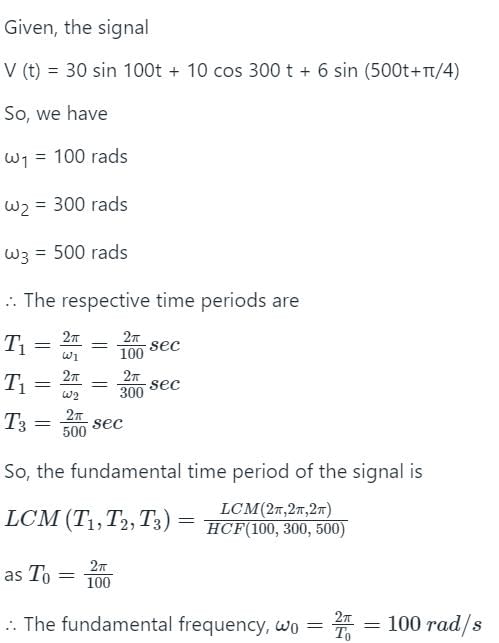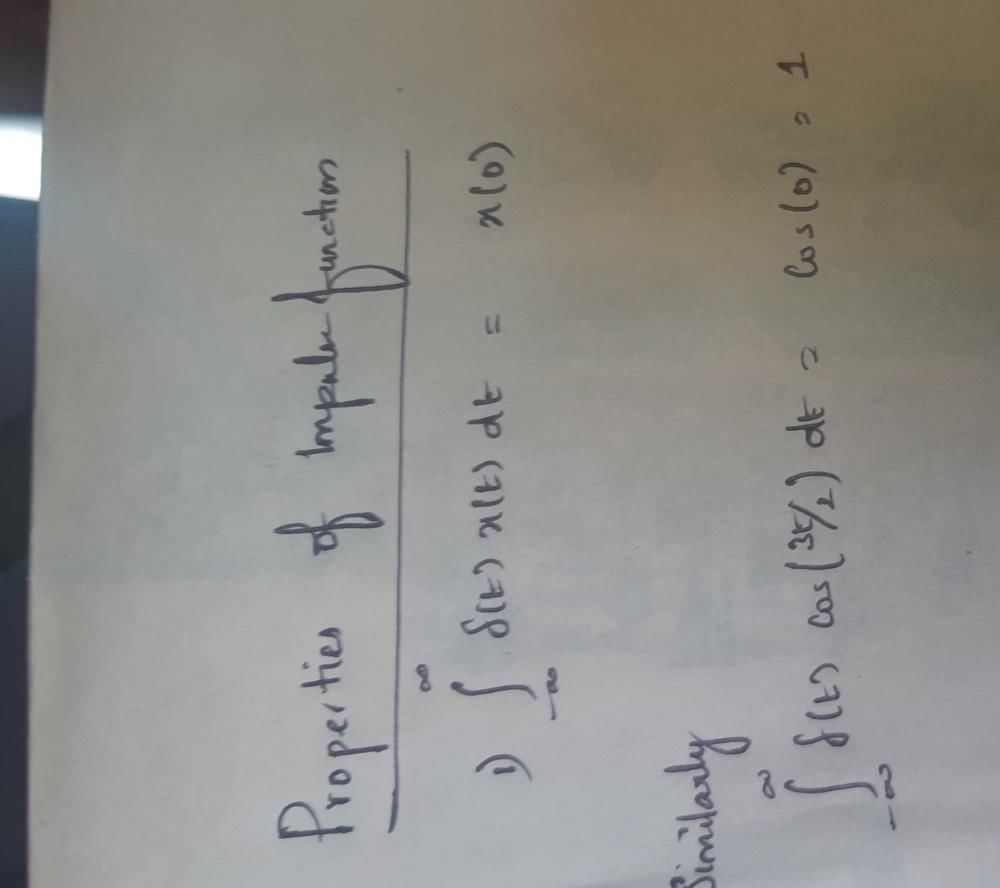GATE Exam > GATE Questions > Let δ(f) is the delta function the valu...
Start Learning for Free
Let δ(f) is the delta function the value of integral 

- a)1
- b)- 1
- c)0
- d)π/2
Correct answer is option 'A'. Can you explain this answer?
Verified Answer
Let δ(f) is the delta function the value of integrala)1b)- 1c)0d...

Most Upvoted Answer
Let δ(f) is the delta function the value of integrala)1b)- 1c)0d...

Free Test
FREE
| Start Free Test |
Community Answer
Let δ(f) is the delta function the value of integrala)1b)- 1c)0d...
Understanding the Signal
The given periodic signal is:
v(t) = 30 sin(100t) + 10 cos(300t) + 6 sin(500t + π/4)
This signal is composed of three different frequency components.
Identifying Frequency Components
- The first term, 30 sin(100t), has an angular frequency of 100 rad/s.
- The second term, 10 cos(300t), has an angular frequency of 300 rad/s.
- The third term, 6 sin(500t + π/4), has an angular frequency of 500 rad/s.
Finding the Fundamental Frequency
To determine the fundamental frequency of a periodic signal, we need to find the greatest common divisor (GCD) of the angular frequencies of each component:
- 100 rad/s
- 300 rad/s
- 500 rad/s
Calculating GCD
- The factors of 100: 1, 2, 4, 5, 10, 20, 25, 50, 100
- The factors of 300: 1, 2, 3, 4, 5, 6, 10, 12, 15, 20, 25, 30, 50, 60, 75, 100, 150, 300
- The factors of 500: 1, 2, 4, 5, 10, 20, 25, 50, 100, 125, 250, 500
The greatest common divisor among these is:
- GCD(100, 300, 500) = 100
Conclusion
Thus, the fundamental frequency of the signal v(t) is 100 rad/s, which corresponds to option 'A'. This frequency is the lowest frequency present in the signal and defines its periodicity.
The given periodic signal is:
v(t) = 30 sin(100t) + 10 cos(300t) + 6 sin(500t + π/4)
This signal is composed of three different frequency components.
Identifying Frequency Components
- The first term, 30 sin(100t), has an angular frequency of 100 rad/s.
- The second term, 10 cos(300t), has an angular frequency of 300 rad/s.
- The third term, 6 sin(500t + π/4), has an angular frequency of 500 rad/s.
Finding the Fundamental Frequency
To determine the fundamental frequency of a periodic signal, we need to find the greatest common divisor (GCD) of the angular frequencies of each component:
- 100 rad/s
- 300 rad/s
- 500 rad/s
Calculating GCD
- The factors of 100: 1, 2, 4, 5, 10, 20, 25, 50, 100
- The factors of 300: 1, 2, 3, 4, 5, 6, 10, 12, 15, 20, 25, 30, 50, 60, 75, 100, 150, 300
- The factors of 500: 1, 2, 4, 5, 10, 20, 25, 50, 100, 125, 250, 500
The greatest common divisor among these is:
- GCD(100, 300, 500) = 100
Conclusion
Thus, the fundamental frequency of the signal v(t) is 100 rad/s, which corresponds to option 'A'. This frequency is the lowest frequency present in the signal and defines its periodicity.

|
Explore Courses for GATE exam
|

|
Question Description
Let δ(f) is the delta function the value of integrala)1b)- 1c)0d)π/2Correct answer is option 'A'. Can you explain this answer? for GATE 2025 is part of GATE preparation. The Question and answers have been prepared according to the GATE exam syllabus. Information about Let δ(f) is the delta function the value of integrala)1b)- 1c)0d)π/2Correct answer is option 'A'. Can you explain this answer? covers all topics & solutions for GATE 2025 Exam. Find important definitions, questions, meanings, examples, exercises and tests below for Let δ(f) is the delta function the value of integrala)1b)- 1c)0d)π/2Correct answer is option 'A'. Can you explain this answer?.
Let δ(f) is the delta function the value of integrala)1b)- 1c)0d)π/2Correct answer is option 'A'. Can you explain this answer? for GATE 2025 is part of GATE preparation. The Question and answers have been prepared according to the GATE exam syllabus. Information about Let δ(f) is the delta function the value of integrala)1b)- 1c)0d)π/2Correct answer is option 'A'. Can you explain this answer? covers all topics & solutions for GATE 2025 Exam. Find important definitions, questions, meanings, examples, exercises and tests below for Let δ(f) is the delta function the value of integrala)1b)- 1c)0d)π/2Correct answer is option 'A'. Can you explain this answer?.
Solutions for Let δ(f) is the delta function the value of integrala)1b)- 1c)0d)π/2Correct answer is option 'A'. Can you explain this answer? in English & in Hindi are available as part of our courses for GATE.
Download more important topics, notes, lectures and mock test series for GATE Exam by signing up for free.
Here you can find the meaning of Let δ(f) is the delta function the value of integrala)1b)- 1c)0d)π/2Correct answer is option 'A'. Can you explain this answer? defined & explained in the simplest way possible. Besides giving the explanation of
Let δ(f) is the delta function the value of integrala)1b)- 1c)0d)π/2Correct answer is option 'A'. Can you explain this answer?, a detailed solution for Let δ(f) is the delta function the value of integrala)1b)- 1c)0d)π/2Correct answer is option 'A'. Can you explain this answer? has been provided alongside types of Let δ(f) is the delta function the value of integrala)1b)- 1c)0d)π/2Correct answer is option 'A'. Can you explain this answer? theory, EduRev gives you an
ample number of questions to practice Let δ(f) is the delta function the value of integrala)1b)- 1c)0d)π/2Correct answer is option 'A'. Can you explain this answer? tests, examples and also practice GATE tests.

|
Explore Courses for GATE exam
|

|
Signup for Free!
Signup to see your scores go up within 7 days! Learn & Practice with 1000+ FREE Notes, Videos & Tests.


















